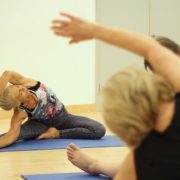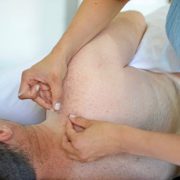Hip Flexors Always Tight? Maybe stop stretching.
When it comes to chronically stiff muscles – tight hip flexors are the second most common complaint I hear after tight hamstrings. Tight hip flexors are annoying, achy, and they often contribute to lower back pain. When your hips are always tight, it can interfere with your ability to enjoy walking, running, golfing, and just exercise in general.
Typically – the recommended treatment for tight hip flexors is to stretch – right along with advice to foam roll and massage. But what do you do when none of that works? What if no matter how often you stretch, the tightness just keeps coming back?
First, you need to make sure that the tightness you feel in your hips is actually due to tight hip flexors. Just because your muscles feel tight – doesn’t mean they are tight.
Let me explain.
Your hip flexors (or any muscle for that matter) can feel tight for different reasons. They can literally be shortened and constricted – in which case – they need stretching – and lots of it. But they can also feel tight due to weakness or being overworked. If your hip flexors are weak, they are going to feel strained when you use them, which can create a sensation of tightness. If your hip flexors are compensating for another underperforming muscle group – say your deep core – then a sensation of tightness may occur because they are simply tired and overworked.
So the first and most important thing you need to figure out is what is causing the sensation of tightness in your hips. Are they actually short and tight? Are they weak? Or do they simply need a break?
Let’s do a quick anatomy review of your hip flexors to help you figure this out…
Your hip flexors consist of the muscle group located in the front of your hip and groin. They are responsible for bending (flexing) your thigh up and toward your chest. But they also play a role in stabilizing your pelvis and lower back – and this is where I see a lot of problems and confusion. The rectus femoris, part of your quadriceps muscle group, and your psoas, part of your deep abdominal muscle group, are the two major hip flexors. Your rectus muscle is the one primarily responsible for lifting (flexing) your thigh. When you are walking or running, and repetitively flexing your leg, this is the muscle primarily at play. Your psoas, on the other hand, is much shorter and has a connection to your lower back. Because of this, it has more of a stability role. When functioning properly, it will assist in exercises like the crunch or sit up, and also work alongside your deep abdominals and glute muscles to help you have good upright posture when you’re sitting or standing.
Let’s talk about the psoas for a moment, because this is where many folks I speak with are misinformed. The psoas gets blamed for a lot of things – most notably – tilting your pelvis forward and being the cause of low back pain. The theory is that if you stretch, massage, and “release” your psoas muscle, then you will balance out your pelvis and your back pain will disappear. Sadly, this is rarely the case. Most of the time, your psoas feels tight because it’s either too weak and not able to keep up with what it’s being tasked to do, or it’s overworking to compensate for your deep abdominals not working properly. Either way, the result will be an angry psoas that retaliates against you by feeling tight and achy. And stretching it over and over again will simply not work.
Now sometimes your hip flexors – particularly your rectus femoris – can get deconditioned from not being used enough – and this can result in actual constriction of your muscle tissue. This typically happens slowly over time, and is more likely to occur if you sit too much and aren’t very active. In this case, you actually do need stretching to fix the problem – but one of the reasons it doesn’t work – is because you aren’t doing it properly. When your muscle tissue is actually constricted – it requires a very specific stretching protocol to work. The days of holding a stretch for 30 sec and repeating it 3x are long over. If your muscle fibers have actually become constricted – the only way for them to improve their length is to remodel. They need a lot of stress to remodel (aka get longer) and the only way to accomplish this is to stretch repeatedly and often.
At the end of the day, if you’ve got chronically tight hip flexors and you’re stretching all the time, you’re either doing it wrong or shouldn’t be doing it at all. Perhaps you need to strengthen your hip flexors so they don’t feel so tense all the time? Or maybe your core isn’t kicking in and you need to strengthen that instead? Don’t stress yourself trying to figure it out on your own.
Talk to an expert who gets this.
Stretching a muscle that feels tight isn’t always your answer, and you’ll know this because stretching over and over just isn’t fixing the problem.
Request to speak to one of my specialists to see if we are the right fit to help get to the root cause of your tight hip flexors. CLICK HERE to request a Free Discovery.
Dr. Carrie Jose, Physical Therapist and Pilates expert, owns CJ Physical Therapy & Pilates in Portsmouth, NH. To get a free copy of her guide to taking care of back pain – click here.





